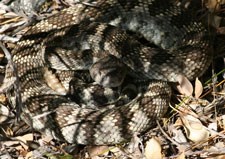
Yosemite National Park contains a high diversity of reptiles. It’s possible to find 22 species, including one turtle, seven lizards, one skink, and 13 snakes, in the park. Lizards
TurtlesYosemite’s lone turtle species, the Western pond turtle, inhabits a wide-range of habitats including habitats including ponds, lakes, marshes, rivers, and streams. Turtles may be found in the Tuolumne River and in several locations in the northwestern portion of the park below 6,500 feet in elevation. The turtle, which is a California Species of Special concern, is believed to be declining throughout most of its range primarily due to habitat loss (including the damming of rivers), non-native predators (bullfrogs, large-mouth bass, and other predartors), and over-harvesting of turtles for food. The greatest threat to pond turtles in the park is invasive bullfrogs; bullfrogs eat hatchlings and young turtles and have been found in locations that also have pond turtles. Western pond turtles are currently being restored to Yosemite Valley where they used to occur in the Merced River in the park. Snakes

Of the 13 species of snakes found in Yosemite, only the Northern Pacific rattlesnake is venomous. The likelihood of encountering one is relatively low. Pay attention when hiking or climbing in dry, rocky places. Watch where you step, especially when stepping over logs, and avoid putting your hands in holes or on ledges where snakes may be sunning themselves. If you do see or hear one, simply detour around it or let the snake move away. Rattlesnakes are an important part of Yosemite’s ecosystem, and should not be harmed. |
Last updated: February 4, 2017
